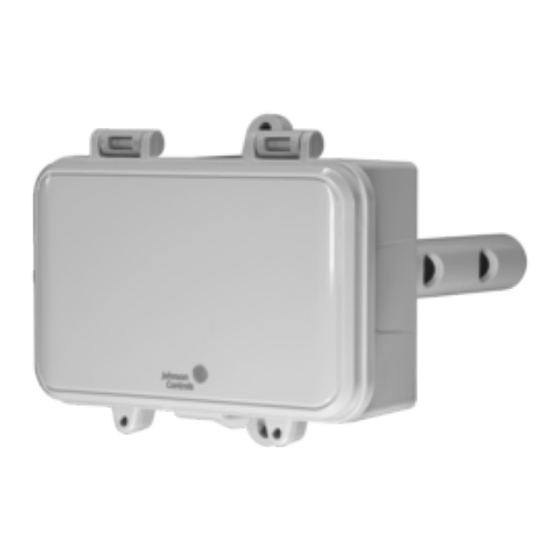
Table of Contents
Advertisement
Quick Links
CD-P00-U Series Duct Carbon
Dioxide Transmitter Installation
Guide
Table of contents
1.
Introduction
2.
3.
4.
5.
1.
2.
3.
6.
7.
8.
Introduction
The CD-P00-U Series Duct CO
nondispersive infrared (NDIR) sensor in an IP67 (NEMA 4) enclosure with a hinged
and gasketed cover and sampling probe for duct applications to monitor CO
The sensor uses dual channel optics and LTA (longterm adjustment) signal processing
technology to deliver industry leading longterm accuracy and reliability. These
technology features ensure optimum measurement stability for both periodic and
constant occupancy applications, so the device is equally suitable for return-air
investment from the classroom or the hospital room.
Standard features include:
Transmitter uses a highly accurate and reliable
2
levels.
2
Advertisement
Table of Contents

Summary of Contents for Johnson Controls CD-P00-U Series
-
Page 1: Table Of Contents
Calibration Technical specifications Introduction The CD-P00-U Series Duct CO Transmitter uses a highly accurate and reliable nondispersive infrared (NDIR) sensor in an IP67 (NEMA 4) enclosure with a hinged and gasketed cover and sampling probe for duct applications to monitor CO levels. -
Page 2: Dimensions
De-energize the power supply prior to installation. This device is intended for indoor air conditioned spaces, contact factory, or other applications. This product is not intended for life-safety applications. Dimensions Figure 1. Dimensions of the CD-P00-U Series Duct Carbon Dioxide Transmitter... -
Page 3: Before Installation
Before installation Read the installation instructions carefully before you install and commission the device. Failure to follow these instructions may result in product damage. This CO sensor incorporates a self-calibration feature to correct CO Note: sensor drift. Use the self-calibration feature for applications where the CO exposed to fresh air (400 ppm) at least 1 h each day. - Page 4 To ensure correct temperature readings, if present, install the temperature Note: inlet on the probe directly into the airflow. See Step 1 of the following figure. Figure 1. Mounting the CD-P00-U Series Duct Carbon Dioxide Transmitter Callout Description Direction of airflow...
-
Page 5: Wiring
holes. To prevent air leaks, ensure the gasket compresses around the probe between the device enclosure and the air duct. See Step 1 of Figure 3. The enclosure has a hinged cover with a latch. To open the cover, pull slightly on the latch on the bottom of the enclosure and at the same time, pull on the cover. - Page 6 Callout Description Figure Figure Figure This is a 3-wire sourcing device. Connect the plus DC or the AC voltage hot side to the PWR terminal and connect the COM to the COM terminal. The device is reverse voltage-protected and does not operate if connected backwards. The device has a half-wave power supply so the supply COM is the same as the signal COM.
-
Page 7: Output Scaling
Callout Description Current, 4 mA to 20 mA Voltage, 0 VDC to 5 VDC or 0 VDC to 10 VDC The optional 2-wire temperature sensor output is available with various RTDs and thermistors to suit all control applications and is available on the TEMP terminals. See the following figure. - Page 8 3. Press the UP or DOWN buttons to scroll through the available options to change the program variables. In the following table, the Specification column shows the LCD display and the default value. Table 1. CD-P00-U Series Duct Carbon Dioxide Transmitter setup menu Specification Description...
- Page 9 Specification Description mA, 0 VDC to 5 VDC, or 0 VDC to 10 VDC) to Reverse (20 mA to 4 mA, 5 VDC to 0 VDC, or 10 VDC to 0 VDC) if you require the reverse action. The factory default is Direct. Output test The Output Test value controls the analog output signal for testing purposes.
- Page 10 Specification Description Rotate All available sensor readings rotate at 2 s intervals None No measurement information displays in normal mode and the menu still displays in Setup Menu mode. Backlight Use the BackLite setting to control how the LCD backlight functions.
-
Page 11: Calibration
Fail if you need to repeat the process. 10. When calibration completes, press MENU to return to normal operation, shut off the gas supply, and remove the sensor adapter. Technical specifications Table 1. CD-P00-U Series Room Carbon Dioxide Transmitter technical specifications... - Page 12 Specification Description Purpose of control Operating control Action Type 1 Pollution degree Impulse voltage 330 V Gas type detected Sensor type Dual channel NDIR Sensor accuracy ±30 ppm + 3% of measured value Measurement range 0 ppm to 2000 ppm (default), adjustable 1000 ppm to 10,000 ppm Pressure dependency ±2.5 ppm/°C...
- Page 13 The performance specifications are nominal and conform to acceptable industry standards. For application at conditions beyond these specifications, consult the local Johnson Controls office. Johnson Controls shall not be liable for damages resulting from misapplication or misuse of its products.















Need help?
Do you have a question about the CD-P00-U Series and is the answer not in the manual?
Questions and answers